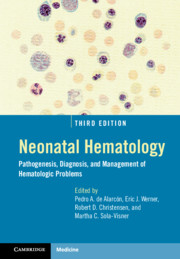Book contents
- Neonatal Hematology
- Neonatal Hematology
- Copyright page
- Contents
- Foreword
- Preface
- Contributors
- Section I Developmental Hematology
- Section II Bone Marrow Failure and Immune Disorders
- Section III Erythrocyte Disorders
- Section IV Platelet Disorders
- Section V Leucocyte Disorders
- Section VI Hemostatic Disorders
- Section VII Neonatal Transfusion Medicine
- Section VIII Neonatal Oncology
- Section IX Miscellaneous
- Index
- Plate Section (PDF Only)
- References
Section II - Bone Marrow Failure and Immune Disorders
Published online by Cambridge University Press: 30 January 2021
- Neonatal Hematology
- Neonatal Hematology
- Copyright page
- Contents
- Foreword
- Preface
- Contributors
- Section I Developmental Hematology
- Section II Bone Marrow Failure and Immune Disorders
- Section III Erythrocyte Disorders
- Section IV Platelet Disorders
- Section V Leucocyte Disorders
- Section VI Hemostatic Disorders
- Section VII Neonatal Transfusion Medicine
- Section VIII Neonatal Oncology
- Section IX Miscellaneous
- Index
- Plate Section (PDF Only)
- References
Summary
Inherited bone marrow failure syndromes (IBMFS) are a rare but important consideration in the differential diagnosis of cytopenias in childhood [1]. However, diagnosis of IBMFS in the newborn period can be challenging because many of the manifestations considered typical for a specific disorder may not yet be present, and in many cases children will not be recognized until later in life. Young children with IBMFS may have one or more cytopenias, congenital anomalies, both, or neither. A high index of suspicion for an IBMFS is required in order to establish the correct diagnosis, determine appropriate clinical management and follow up plans, and provide the family with genetic counseling. Some IBMFS predispose to leukemia or solid tumors; while the development of cancer is uncommon in the newborn period, this risk is an important determinant of subsequent follow up for the child and any affected family members.
- Type
- Chapter
- Information
- Neonatal HematologyPathogenesis, Diagnosis, and Management of Hematologic Problems, pp. 43 - 92Publisher: Cambridge University PressPrint publication year: 2021

